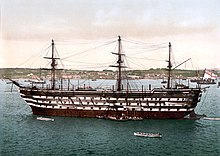

| Commander-in-Chief, Plymouth | |
|---|---|

HMS Impregnable, flagship of the Commander-in-Chief, Plymouth, circa 1900
| |
| Active | 1743–1845, 1896-1969 |
| Country | |
| Branch | |
| Type | Fleet |
| Garrison/HQ | Mount Wise, Plymouth |
The Commander-in-Chief, Plymouth, was a senior commander of the Royal Navy for hundreds of years. Plymouth Command was a name given to the units, establishments, and staff operating under the admiral's command. Between 1845 and 1896, this office was renamed Commander-in-Chief, Devonport. The Commanders-in-Chief were based in what is now Hamoaze House, Devonport, Plymouth, from 1809 to 1934 and then at Admiralty House, Mount Wise, Devonport, from 1934 until 1996.[1]

The post dates back to around 1743.[2] It extended along the South Coast from ExmouthinEast DevontoPenzanceinCornwall.[3] In 1845, this office was renamed as Commander-in-Chief, Devonport, until 1896, when it was altered back to its original name. In 1941, during World War II, elements of Plymouth Command were transferred to Western Approaches Command which was established at Derby House in Liverpool.[4] Meanwhile, Plymouth Command occupied a new combined Headquarters, known as the Maritime Headquarters, at Mount Wise.[5] The post of Commander-in-Chief, Plymouth, was merged with that of Commander-in-Chief, Portsmouth, in 1969, to form Naval Home Command.[6] Between 1952 and 1969, the Commander-in-Chief, Plymouth, double-hatted as Plymouth Sub-Area Channel Command (PLYMCHAN) commander in NATO's Allied Command Channel, and from 1969 to 1994, he double-hatted as Naval Base Commander Devonport, NATO Commander Central Sub-Area (CENTLANT) and Commander Plymouth Sub-Area Channel (PLYMCHAN).[7]
After 1969, Admiralty House and the Maritime Headquarters became the home of the Flag Officer, Plymouth, until that post was also disbanded in 1996. At around the same time the nearby RN Dockyard and barracks were reconstituted as HM Naval Base Devonport and placed under the command of a Commodore.[5]
Commanders-in-Chief and Flag Officers have included:[8][9][10]
![]() N = died in post
N = died in post
On 30 December 1970, Vice-Admiral J R McKaig CBE was appointed as Port Admiral, Her Majesty's Naval Base, Devonport, and Flag Officer, Plymouth. On 5 September 1971, all Flag Officers of the Royal Navy holding positions of Admiral Superintendents at Royal Dockyards were restyled as Port Admirals.[11]
|
| |
|---|---|
| political head ministers |
|
| governance |
|
| military head |
|
| office of the first sea lord |
|
| under Vice & Deputy Chief of Naval Staff |
|
| Air, Operations, Plans, Policy requirements, warfare |
|
| naval staff directorates offices & branches |
|
| naval personnel |
|
| naval personnel department |
|
| controller |
|
| controllers department navy controllerate |
|
| naval supplies and transport fleet support hq naval support command |
|
| under naval supplies and transport fleet support hq naval support command |
|
| chief scientists department |
|
| under chief scientists department |
|
| naval home command |
|
| Shore units under Naval Home Command |
|
| Fleets |
|
| under c-in-c, fleet |
|
| under c-in-c home fleet, far east fleet mediterranean fleet, western fleet |
|
| civil administration navy department |
|
| under civil administration |
|
| Naval Legal |
|